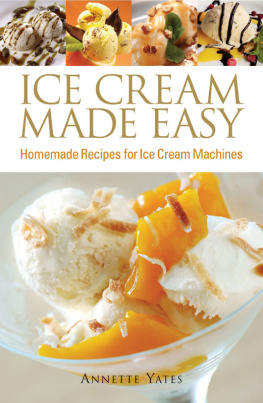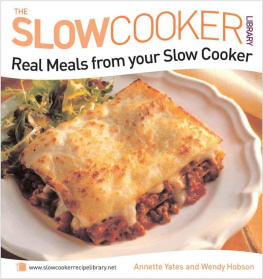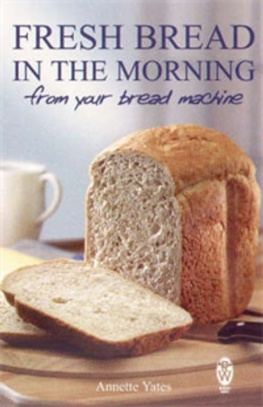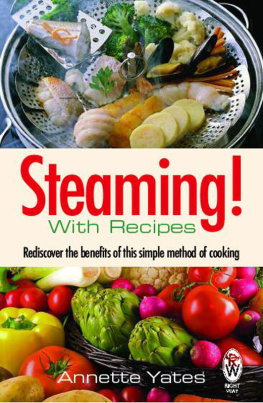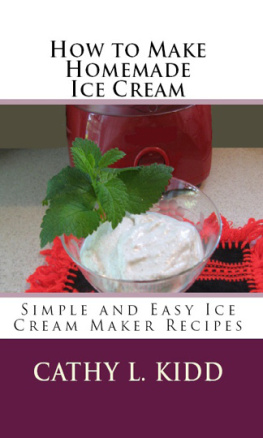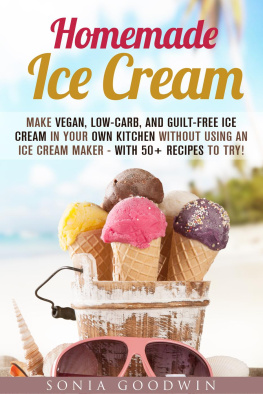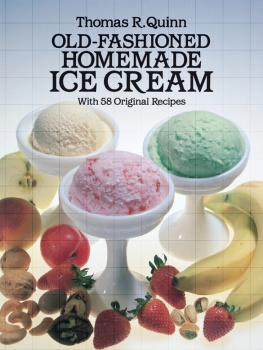ICE CREAM MADE EASY
By the same author
Fresh Bread in the Morning from your Bread Machine
Slow Cooking: Best New Recipes
The Blender Book
Steaming!
Super Soups &Sauces
The Combination Microwave Book
Microwave Cooking Times at a Glance!
ICE CREAM MADE EASY
HOMEMADE RECIPES FOR ICE CREAM MACHINES
Annette Yates
Constable & Robinson Ltd
5556 Russell Square
London WC1B 4HP
www.constablerobinson.com
Originally published in the UK 2004 under the title Ice n Easy
This edition published by Right Way, an imprint of Constable &Robinson, 2009
Copyright Constable &Robinson 2009
All rights reserved. This book is sold subject to the condition that it shall not, by way of trade or otherwise, be lent, re-sold, hired out or otherwise circulated in any form of binding or cover other than that in which it is published and without a similar condition including this condition being imposed on the subsequent purchaser.
A copy of the British Library Cataloguing in Publication Data is available from the British Library
ISBN: 978-0-7160-2226-8
e-ISBN: 978-0-7160-2324-1
Printed and bound in the EU
CONTENTS
DEDICATION
This book is for my daughters Emma and Lindsay avid fans of my art.
ACKNOWLEDGEMENTS
My thanks go to Gaggia, Magimix and Philips for their generosity in supplying ice cream machines with which to test the recipes in this book.
1
FROZEN ASSETS
Make no mistake, I adore making ices in my ice cream machine. Its the spontaneity, the sheer indulgence and the satisfaction of creating a luscious, frozen concoction out of a few well-chosen ingredients that makes me happy. It means I can make any flavour that takes my fancy and the choice of ingredients is up to me. Unlike many commercial products, my ices contain no thickeners, emulsifiers, artificial flavourings and colouring, preservatives or stabilisers.
Admittedly, making my own ice cream is not cheap using the best fresh ingredients often costs more than a tub of ready-made. Nonetheless, in all the years I have used an ice cream machine, the only time I have been tempted to buy a carton is to check the flavour before making a similar (and usually better) one myself.
Frosty treats like creamy ice cream, light-and-airy frozen yogurts, silky sorbets, frozen desserts and slushy drinks seem to appeal to most of us, no matter what our age. In this book there is something to suit every occasion.
The recipes in Ice Cream Made Easy are all nice and easy! There are no difficult methods involved just simple ingredients that require minimal preparation before being freeze-churned in the ice cream machine. In fact, they are likely to be the easiest ices you have ever made.
2
ICE CREAM MACHINES
There is no doubt that ice cream made in a machine is smoother, creamier and lighter than one made by hand. In a machine, the same ingredients will make a larger quantity of ice cream too.
An ice cream machine works by gradually freezing the ice cream mixture while simultaneously churning it to a creamy concoction. Its this churning process that makes the finished ice smooth, light and airy by keeping the mixture moving, it prevents the formation of large ice crystals and beats in air.
When choosing an ice cream machine, always look at the manufacturers booklet before buying. Are the instructions clear? Is there a good selection of recipes? Is the machine easy to use and clean?
A fully automatic ice cream machine with a built-in freezer unit is not cheap. However, if you love making a quick batch of ice cream at a moments notice, just when the fancy takes you, and you have plenty of space on your kitchen worktop, you will probably consider it worth the investment. In my experience this type of machine makes ice cream with the silkiest consistency and never fails to draw envious comments from visiting friends.
In all models, the freezer unit (or compressor) is cleverly built in to the neat body of the machine.
In some models the motor is housed in the body of the machine and the paddle is powered from the base of the bowl to make the churning process smooth, secure and fairly quiet (see ), which can make them slightly fiddlier to use and to clean.
To make ice cream, you simply switch on the freezer unit and wait a few minutes until the correct temperature is reached. Then switch on the paddle and, while it is turning, add the ingredients and leave the rest to the machine. While you get on with other things, the machine automatically gets on with freezing and churning so that, just about 20 minutes later, your ice cream will be ready.
Fig. 1. A fully automatic ice cream machine with the paddle in the base.
The machine usually comes with a removable bowl that sits inside the main, fixed bowl. The chief advantage is its ease of removal and cleaning, though it will of course be smaller than the main bowl (and will therefore make slightly less ice cream). To use it, you will need to pour a conductive material such as alcohol or salt solution between the two bowls the manufacturers instructions will give full details.
Its worth mentioning that all these machines are fairly bulky and heavy. Also, they do not take well to being moved around (the working balance of the freezing unit can be disturbed) so you will need to find an area of kitchen worktop that you can devote exclusively to your ice cream machine. On the occasions when you do need to move it, do so with care and make sure the machine is kept upright. If you really must keep it in a cupboard, be sure to put it in its working position a couple of hours before you use it (to allow the coolant inside it to settle).
Fig. 2. A fully automatic ice cream machine with the paddle fitted in the lid.p
One final note! If, like me, you are likely to want to make several batches of ice cream (with different flavours perhaps) one after the other, you will probably need a machine with a paddle that is powered from the base of the bowl. These models dont usually require a rest period between uses, so you can simply give the bowl a quick wipe out before adding the next batch of ingredients.
An ice cream machine with a detachable bowl (see opposite) is easily more affordable than a fully automatic model and is capable of making small quantities of lovely ice cream. Some are more efficient than others at preventing large ice crystals forming, which means that the texture of the ice cream can differ slightly from model to model, and they tend to be more noisy than the automatic machines.
The detachable bowl contains a coolant that is sealed in its walls (shake the bowl and you will hear, and feel, it sloshing around). Before using, the bowl needs to be pre-frozen in the freezer, usually for 1224 hours depending on the model. During freezing, it must be placed upright so that the coolant is evenly distributed. Once it is completely frozen (shake it and there should be no movement of the coolant) it is ready to use.
The motorised paddle is fixed to the top of the frozen bowl and, while the paddle is turning, the ingredients are poured in through the chute. Churning time will depend on the model of ice cream machine and the quantity of mixture being frozen anything between 20 and 40 minutes.

